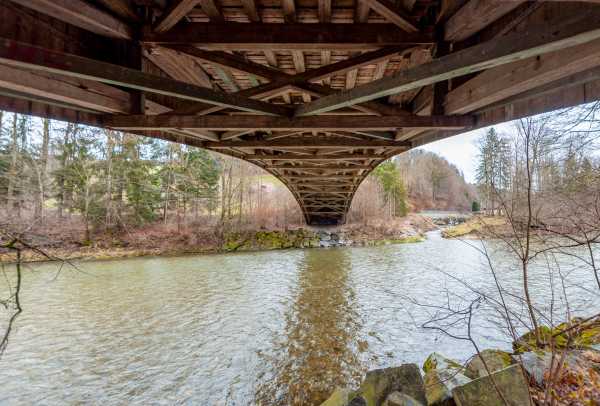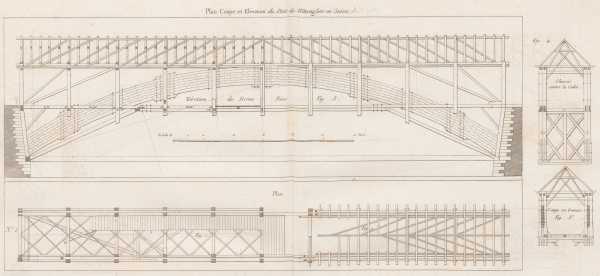Swiss Timber Arch Bridges
Switzerland has always been a transit country and has always depended on efficient transport routes, which, due to the topography, required the construction of numerous bridges. Many of them were made of wood, certainly due to the ubiquitous availability of the material and the high level of carpentry experience in the country. This heritage of wooden bridges − the oldest surviving examples of which date back to the 16th century − is unique in Europe in its number and its state of preservation.
The river courses, which were particularly prone to flooding, or the depth of some gorges, required structures with as few supports as possible. Dreadful floods, which carried debris and caused the bridges to collapse, spurred the carpenters' inventiveness to increase the free spans of the wooden constructions. In this context, the bridges of the Grubenmann family of master builders became particularly well known in the second half of the 18th century.
With the construction of the Limmat Bridge in Wettingen in 1766 by the brothers Johann and Hans Ulrich Grubenmann, wooden arches were firstly introduced as bearing structures. Such arches were not to become as widespread as other load-bearing systems, such as rod polygons. However, 16 examples of this elaborate construction were erected in Switzerland, seven of which have survived to the present day (some of them relocated). These bridges, built between 1803 and 1839 with spans of 20 to 60 metres, offer an extraordinary insight into the capability of historical carpentry.
The construction of the arches was particularly complex, as the individual elements of the multi-layered system had to be mechanically bent. In addition, most of the bridges exhibit complex interlocking joints between the individual lamellas. The constructions therefore quickly attracted international attention, as evidenced by their publication in the treatises of Mechel (1803), Krafft (1805), Gauthey (1813), Rondelet (1830) and Emy (1841). Furthermore, it is likely that the dissemination of these systems exerted an influence on the later development of glued laminated timber.
The current project, launched in 2020, aims to study the surviving Swiss timber arch bridges, with a particular focus on construction techniques and load-bearing behaviour. Through a combination of hand measurements, laser scanning and drone imagery, the present research provides the keys to understanding this highly specialised craft. Based on detailed drawings, HBIM models and FE analyses, the different systems are compared in terms of material use, labour efficiency, design principle and structural performance. Archival and literature research complements these findings with the historical background which led to the emergence of timber arch bridges.
Project team
Research objects
 Bridge of Hasle (image: C. Knobling, 2020).
Bridge of Hasle (image: C. Knobling, 2020). Bridge of Schüpbach (image: C. Knobling, 2020).
Bridge of Schüpbach (image: C. Knobling, 2020). Bridge of Wettingen (source: J.C. Krafft, 1805, plate 22).
Bridge of Wettingen (source: J.C. Krafft, 1805, plate 22). Surveys of bridges with interlocking arches (survey: L. Vandenabeele and C. Knobling, 2021, drawing: L. Vandenabeele).
Surveys of bridges with interlocking arches (survey: L. Vandenabeele and C. Knobling, 2021, drawing: L. Vandenabeele). Comparison of structural behaviour of arch, polygonal and trussed bridges (image: L. Vandenabeele, 2021).
Comparison of structural behaviour of arch, polygonal and trussed bridges (image: L. Vandenabeele, 2021).
Contact
Bauforschung u.Konstruktionsgesch.
Wolfgang-Pauli-Str. 27
8093
Zürich
Switzerland
